Abstract
The paper analyzes a possible improvement of Pulse Width Modulation (PWM) fed motor insulation according to a principle developed by the high voltages industry. The proposed principle consists in using a specific enameled wire made with an additional semi-conductive layer on its outer surface.
Experimental study is realized in order to measure Partial Discharges (PDs) activity with three technologies: Classical enameled wire, enameled wire with an external conductive layer (silver paint) and enameled wire with an external semi-conductive layer (2% of carbon nanoparticles). Simulations are made in order to understand the behavior of the new semi-conductive wire.
1 Introduction
Semi-conductive tapes are widely used in connection boxes of high voltage cables [1]. They are also used for getting a correct potential distribution in the end-winding connections of large big machines working in high voltages [2]. These two applications concern macroscopic objects,which sizes are more than 10 centimeters. For getting a better electric fields distribution in critical parts, strict rules must be respected for the position of the additional semi-conductive tape.
In a low voltage motor fed by a PWM inverter, similar electric fields exist, but in microscopic areas between the turns of the enameled wire or between the surface of the enameled wire and the magnetic core [3]. The problem is critical for machine working in low-pressure environments, as in aeronautics. The electric fields amplitudes are similar to those of the high voltage industry but not the geometry sizes. Therefore, the electrostatic problems are similar, but at a microscopic scale. The manual methods used for decades in high voltage industry cannot be used but their principles remain valid.
The paper proposes to using an enameled wire made with an additional semi-conductive layer on its external surface for making low-voltage electrical machines fed by PWM inverters. Experimental and simulation approaches are achieved in order to study this proposed solution.
The presented approach is a step toward the design of electrical machine by moving PDs towards critical zones, near the coil connections.Additional small balls of varnish at this area, strongly increase the PDIV of the coil.
2 Partial discharge detection: experimental setup description
Electrical machine insulation degradation is linked to Partial Discharges (PDs) that corresponds to the ionization of the air in the vicinity of the enameled wires. During the ionization phenomenon of the air, the charges are deposited on the outer surface of the insulating layer covering the copper wires (Figure 1). This phenomenon is faster than one microsecond; it causes an equivalent current pulse on the external electrical circuit.
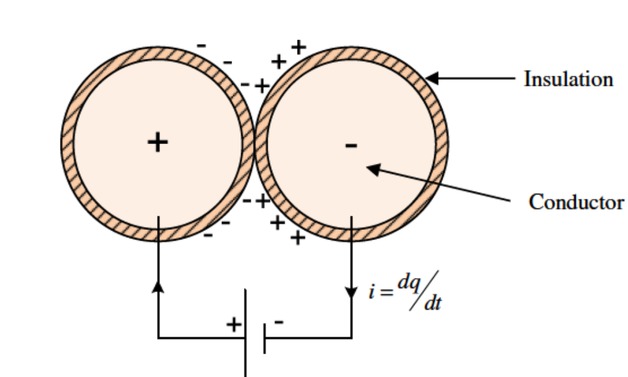
Diagram of partial discharge current formation in twisted pair.
For studying the effects of the conductive layer on PDs, measurements have been carried out, according to the IEC 60270 standard [4]. Figure 2 presents the test bench where:
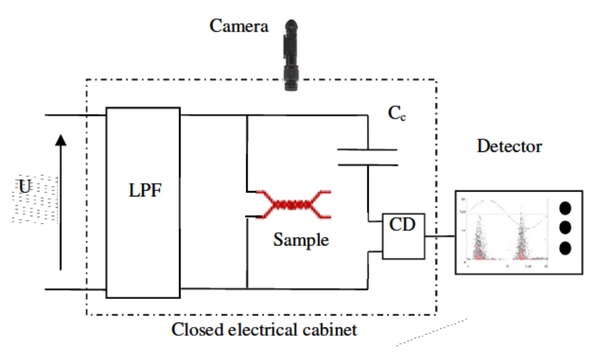
Simplified test bench of the partial discharge detection.
U: variable 50Hz sinusoidal voltage supply;
LPF: low pass filter reducing noise of power supply;
Sample: twisted pair under testing;
Cc: coupling capacitor;
CD: Coupling Device transfers partial discharge signal to the detector;
Detector: shapes the signal and displays on LCD screen.
Camera: night vision device.
All these elements are put into a closed cabinet for electrical safety and also to reduce electromagnetic noise. Pictures were made in a deep darkness with a night vision device called "CoronaFinder" [5] placed at 0.8m of the twisted pairs. This optical system is able to make a visible image from the UV and IR radiation emitted by PDs.
3 Effects of an additional semi-conductive layer
In a motor coil, the outer surfaces of the wires are in contact together. Therefore, an additional semi-conductive external layer creates equipotential surfaces that reduce strongly electric field in the air between the turns. The electric field is concentrated in the inner layers of polymer of the enameled wire insulation, which can withstand high electrical fields [6]. With the thin semi-conductive additional layer, the critical zones, corresponding to high field magnitudes in air, are moved towards the ends of the semi-conductive layer.
The first investigations were made on twisted pairs specimens insulated by classical insulation materials. A typical enameled wire is covered of 10 polymer thin layers for avoiding air-voids. The inner ones are made of polyester-imide (PEI) for getting a good adhesion on the copper. The final ones are made of polyamide-imide (PAI), for getting better thermal properties. Twisted pairs have been prepared according to IEC 60851-5 [7].
The second investigations are achieved with additional conductive layers. On some specimens, a silver conductive paint [8], is added on external layer (Figure 3). The upper sample shows a standard twisted pair and the lower one, a similar twisted pair with an additional silver thin.
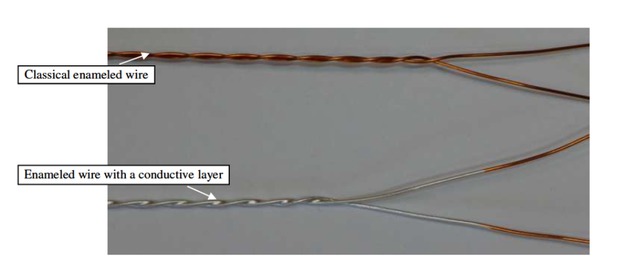
Standard twisted pair and another one covered with a thin layer of silver conductive paint.
A 50Hz sine voltage, over the PDIV (1800Vpeak), feeds the two twisted pair. The upper photography of Figure 4 corresponds to the standard twisted pair; the lower one to the twisted pair covered with the conductive paint. It can be seen that PDs are distributed along the standard twisted pair, but only on the extremities for the modified twisted pair.
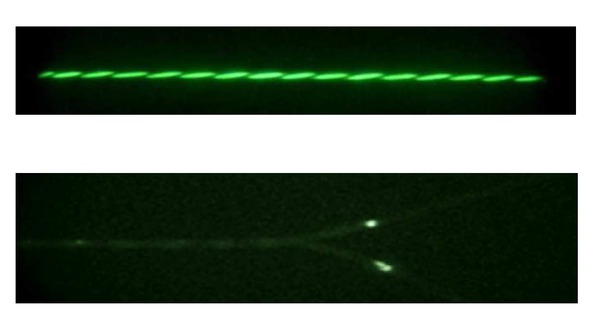
Pictures of twisted pairs in darkness taken by a night vision device at identical voltages (upper picture: standard wire; lower one: modified pair).
4 Investigations on an enameled wire with a new additional semi-conductive layer
Obviously, it is impossible to use a conductive paint in a motor winding, because the high electric conductivity of the paint would be equivalent to short circuited turns. The induced current by the variation of the magnetic flux should destroy the winding. However, a better field distribution does not need a high electric conductivity because, at industrial frequencies, the electric field can be considered as static. The influence of the stray capacitances can be neglected. This study highlights the effects of an additional external layer with lower conductivity. It is made of polyamide-imide (PAI) with 2%of carbon particles. These wire samples were used to make standard twisted pairs for taking pictures of PD activity with the same optical device at the same voltage (1800V). Figure 5 allows to compare the results: PDs are homogeneously distributed along the twisted pair made with the standard wire but they are not on the second one that uses enameled wire with the external semi-conductive layer. The brightness of the image of PDs is obviously lower. The optical system tuning is the same and the camera pause time also.
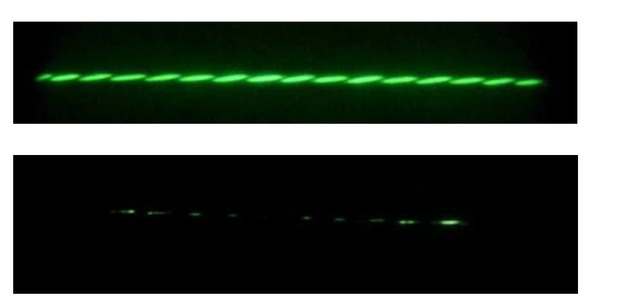
PDs pictures in both twisted pairs under identical voltages. Upper picture: standard enameled wire. Lower picture: enameled wire with the external semi-conductive layer.
The lower picture do not show any concentration of PDs at the ends of the semi-conductive layer as it is observed in tests made with an enameled wire covered by a conducting paint, which has a much higher conductivity (lower part of Figure 4).
5 Simulation approach
A numerical model that uses an equivalent circuit of twisted pair made from enamelled wire with semi-conductive layer is proposed. It is illustrated in Figure 6. The parameters determination is a very important step for a correct estimation of voltage variations. All the circuit parameter values were measured (Ci and Ri), except the contact resistance between the surfaces of the wires (boundary of air area, Rci), as this is impossible.
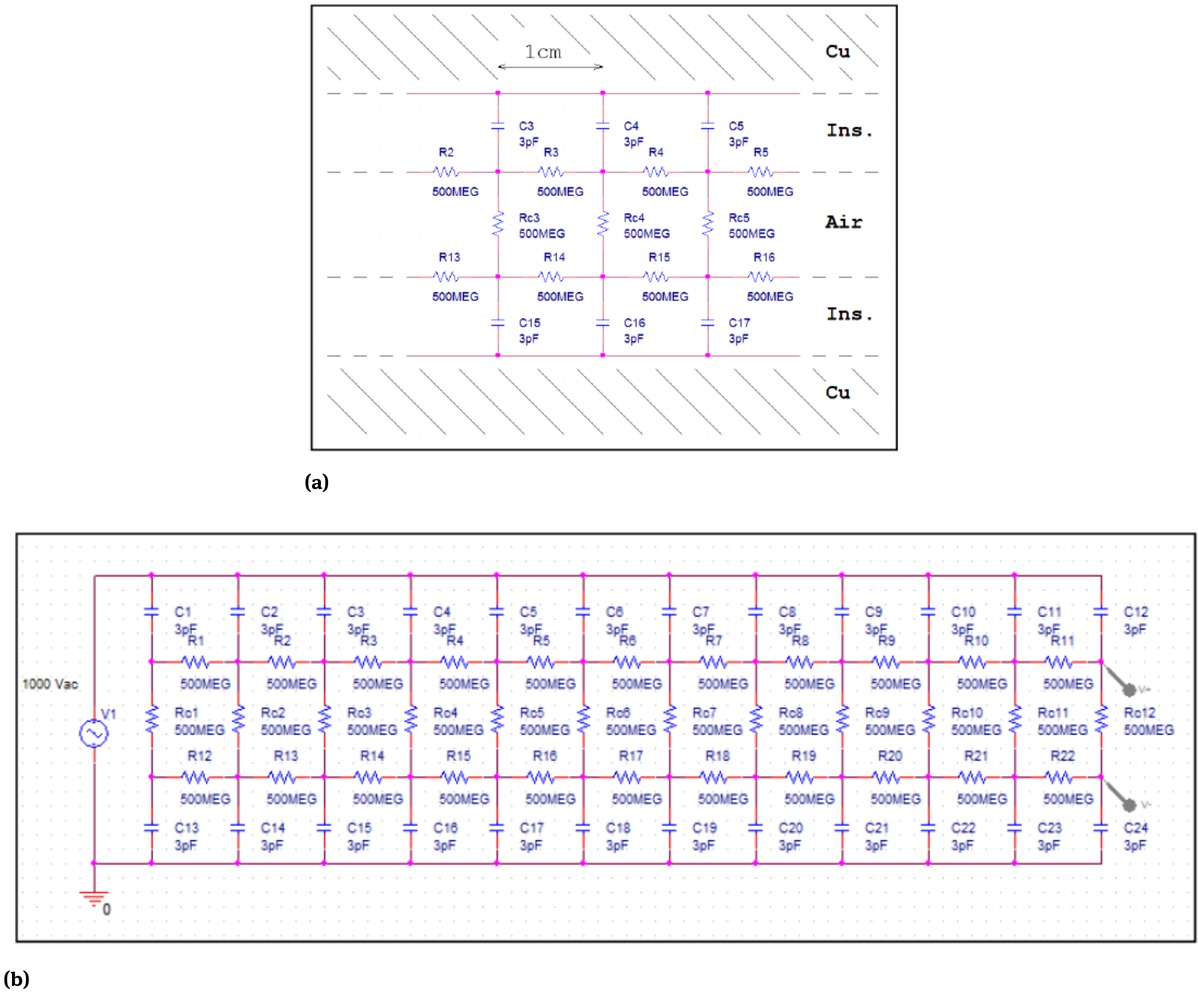
Equivalent circuit of a twisted pair with semi-conductive external layer.
Firstly, the resistance of this additional semi-conductive layer is measured by using an experimental sensor device based on the low current measurement method, described by C. Lattès at the beginning of the last century [9]. The today version of this sensor is made with an ultra-low input current integrator, the IVC102 [10]. The principle is presented in Figure 7. The external semi-conductive layer is used as input resistance. The rectangular input voltage and the triangular output one are presented in Figure 8. The input current is proportional to the slope (dv/dt) of the output voltage. This sensor, calibrated by using a standard resistance, is able to measure currents down to 10pA.
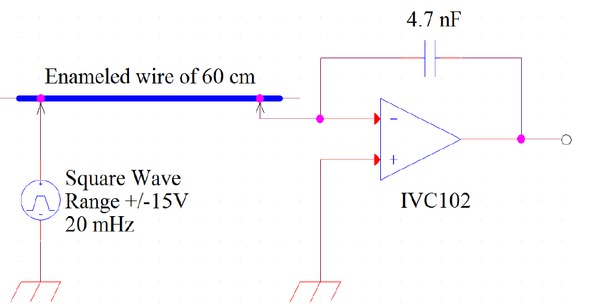
Simplified diagram of the low current measurement.
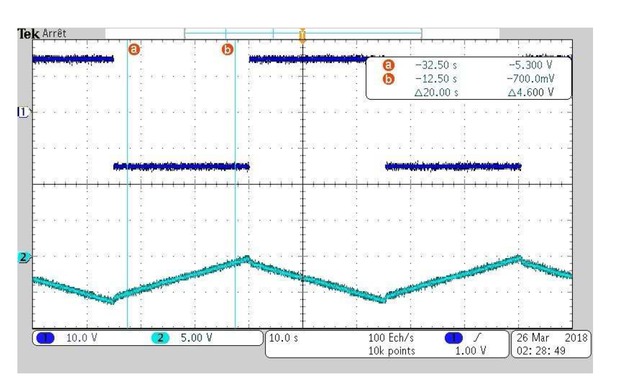
Input (Square) and output (Triangular) voltages of the measuring circuit.
Resistance was measured for several lengths of wire. From Figure 9, the resistance is approximated to 25Gfor 50cm of wire, so 50G/m. Hence, for the numerical model 500M/cm was used as the horizontal resistance Ri.
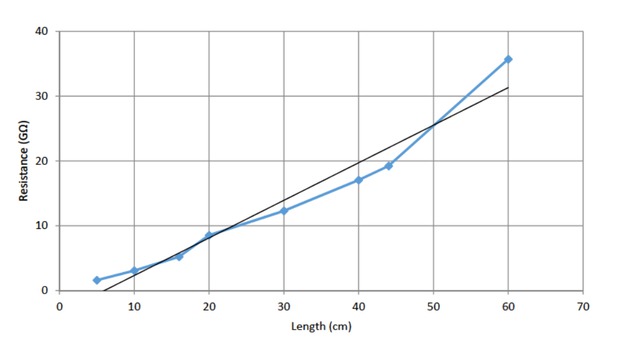
Resistance measurement for several length of the enameled wire with an external semi-conductive layer. Experimental point (blue) and average slope of 500MΩ/cm (black).
For getting the equivalent capacitance per centimeter of the twisted pair, the Agilent 4294A precision impedance analyzer is used [11]. The equivalent capacitance of two insulation layers in series is equal to 1.5pF/cm; thus for the proposed model Ci=3pF per insulation.
In order to study the effect of the contact resistance (Rci), simulation starts from 500M, that corresponds to the horizontal resistance (of the semi-conductive layer) and then, lower value have been used to see the voltage distribution in air. As it is illustrated on Figure 10, the voltage at the boundary of the air layer decreases with this unknown resistance. Under 50Mthe voltage is lower than the PDIV (550V).
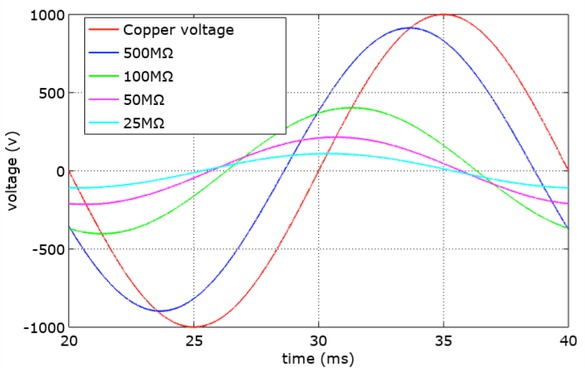
Variation of the voltage depending on the contact resistance between surface wires.
6 Conclusion
A new approach for designing ac motor windings free of partial discharges (PDs) is proposed. It consists of adding a thin semi-conductive layer on the outer surface of enameled wires. Thereby, the electrical fields in the residual air-voids existing between turn will be reduced. Two enameled wires with conductive (silver paint) and semi-conductive (PAI+2% of carbon nanoparticles) external layers have been tested and compared to a classical one. In the first case, PDs occur only at the end of the conductive layer, on the edge of conductive area, rather than randomly, along the turns. Critical zones are well localized. A small additional quantity of varnish in these critical zones, can increase strongly the PDIV. In the second case a mitigation of PD is obtained along the twisted pair, but not the concentration effect on deterministic critical zones. The experimental semiconcuctive layer had a very high specific resistance (31G/m) compared to the silver conducting paint.
Works are in progress for finding an acceptable balance between the PDs concentrations effects that creates a higher PDIV and the additional Joule losses due to the eddy currents in the semi-conductive external layer. Experimental developments must be performed with several kind of conductive particles and different concentrations in order to reduce the value of the contact resistance. This will provide a lower voltage and therefore a reduced electrical stress.
References
[1] Ye H., Fechner T., Lei Y., Luo T., Zhou M., Han Z., Wang H., Zhuang Q., Xu R., Li D., Review on HVDC cable terminations, High Voltage, IET, 1-30, 2018.10.1049/hve.2017.0144Search in Google Scholar
[2] Krpal O., Mraz P., V-A Characteristic Measuring of Stress Grading Tapes in the End-winding of Synchronous Generators, Proc. Engin., Elsevier, 2014, 1523-1528.10.1016/j.proeng.2014.03.150Search in Google Scholar
[3] Stone G. C., Culbert I., Boulter E. A., Dhirani H., Electrical insulation for rotating machines-design, evaluation, aging, testing, and repair, Wiley-IEEE Press, Hoboken, NJ, 2014.10.1002/9781118886663Search in Google Scholar
[4] Standard IEC 60270, High-voltage test techniques. Partial discharge measurements, 3rd ed, 2000.Search in Google Scholar
[5] http://syntronics.net/coronafinder.htmlSearch in Google Scholar
[6] Roger D., Ait-Amar S., Napieralska E., A method to reduce partial discharges in motor windings fed by PWM inverter, De Gruyter, Open Physics , 2018, Vol 16, No. 1 pp. 599-604.10.1515/phys-2018-0078Search in Google Scholar
[7] Standard IEC 60851-5, Winding wires. Test methods. Part 5: Electrical properties, 4th ed, 2008.Search in Google Scholar
[8] https://www.electrolube.com/pdf/tds/044/SCP.pdfSearch in Google Scholar
[9] Lattes C., Methode de mesure des faibles courants, Radium (Paris) 6(3), 1909.10.1051/radium:019090060307301Search in Google Scholar
[10] http://www.ti.com/lit/ds/symlink/ivc102.pdfSearch in Google Scholar
[11] https://www.upc.edu/sct/ca/documents_equipament/d_271_id-658.pdfSearch in Google Scholar
© 2019 S. Ait-Amar et al., published by De Gruyter
This work is licensed under the Creative Commons Attribution 4.0 International License.
Articles in the same Issue
- Regular Articles
- Non-equilibrium Phase Transitions in 2D Small-World Networks: Competing Dynamics
- Harmonic waves solution in dual-phase-lag magneto-thermoelasticity
- Multiplicative topological indices of honeycomb derived networks
- Zagreb Polynomials and redefined Zagreb indices of nanostar dendrimers
- Solar concentrators manufacture and automation
- Idea of multi cohesive areas - foundation, current status and perspective
- Derivation method of numerous dynamics in the Special Theory of Relativity
- An application of Nwogu’s Boussinesq model to analyze the head-on collision process between hydroelastic solitary waves
- Competing Risks Model with Partially Step-Stress Accelerate Life Tests in Analyses Lifetime Chen Data under Type-II Censoring Scheme
- Group velocity mismatch at ultrashort electromagnetic pulse propagation in nonlinear metamaterials
- Investigating the impact of dissolved natural gas on the flow characteristics of multicomponent fluid in pipelines
- Analysis of impact load on tubing and shock absorption during perforating
- Energy characteristics of a nonlinear layer at resonant frequencies of wave scattering and generation
- Ion charge separation with new generation of nuclear emulsion films
- On the influence of water on fragmentation of the amino acid L-threonine
- Formulation of heat conduction and thermal conductivity of metals
- Displacement Reliability Analysis of Submerged Multi-body Structure’s Floating Body for Connection Gaps
- Deposits of iron oxides in the human globus pallidus
- Integrability, exact solutions and nonlinear dynamics of a nonisospectral integral-differential system
- Bounds for partition dimension of M-wheels
- Visual Analysis of Cylindrically Polarized Light Beams’ Focal Characteristics by Path Integral
- Analysis of repulsive central universal force field on solar and galactic dynamics
- Solitary Wave Solution of Nonlinear PDEs Arising in Mathematical Physics
- Understanding quantum mechanics: a review and synthesis in precise language
- Plane Wave Reflection in a Compressible Half Space with Initial Stress
- Evaluation of the realism of a full-color reflection H2 analog hologram recorded on ultra-fine-grain silver-halide material
- Graph cutting and its application to biological data
- Time fractional modified KdV-type equations: Lie symmetries, exact solutions and conservation laws
- Exact solutions of equal-width equation and its conservation laws
- MHD and Slip Effect on Two-immiscible Third Grade Fluid on Thin Film Flow over a Vertical Moving Belt
- Vibration Analysis of a Three-Layered FGM Cylindrical Shell Including the Effect Of Ring Support
- Hybrid censoring samples in assessment the lifetime performance index of Chen distributed products
- Study on the law of coal resistivity variation in the process of gas adsorption/desorption
- Mapping of Lineament Structures from Aeromagnetic and Landsat Data Over Ankpa Area of Lower Benue Trough, Nigeria
- Beta Generalized Exponentiated Frechet Distribution with Applications
- INS/gravity gradient aided navigation based on gravitation field particle filter
- Electrodynamics in Euclidean Space Time Geometries
- Dynamics and Wear Analysis of Hydraulic Turbines in Solid-liquid Two-phase Flow
- On Numerical Solution Of The Time Fractional Advection-Diffusion Equation Involving Atangana-Baleanu-Caputo Derivative
- New Complex Solutions to the Nonlinear Electrical Transmission Line Model
- The effects of quantum spectrum of 4 + n-dimensional water around a DNA on pure water in four dimensional universe
- Quantum Phase Estimation Algorithm for Finding Polynomial Roots
- Vibration Equation of Fractional Order Describing Viscoelasticity and Viscous Inertia
- The Errors Recognition and Compensation for the Numerical Control Machine Tools Based on Laser Testing Technology
- Evaluation and Decision Making of Organization Quality Specific Immunity Based on MGDM-IPLAO Method
- Key Frame Extraction of Multi-Resolution Remote Sensing Images Under Quality Constraint
- Influences of Contact Force towards Dressing Contiguous Sense of Linen Clothing
- Modeling and optimization of urban rail transit scheduling with adaptive fruit fly optimization algorithm
- The pseudo-limit problem existing in electromagnetic radiation transmission and its mathematical physics principle analysis
- Chaos synchronization of fractional–order discrete–time systems with different dimensions using two scaling matrices
- Stress Characteristics and Overload Failure Analysis of Cemented Sand and Gravel Dam in Naheng Reservoir
- A Big Data Analysis Method Based on Modified Collaborative Filtering Recommendation Algorithms
- Semi-supervised Classification Based Mixed Sampling for Imbalanced Data
- The Influence of Trading Volume, Market Trend, and Monetary Policy on Characteristics of the Chinese Stock Exchange: An Econophysics Perspective
- Estimation of sand water content using GPR combined time-frequency analysis in the Ordos Basin, China
- Special Issue Applications of Nonlinear Dynamics
- Discrete approximate iterative method for fuzzy investment portfolio based on transaction cost threshold constraint
- Multi-objective performance optimization of ORC cycle based on improved ant colony algorithm
- Information retrieval algorithm of industrial cluster based on vector space
- Parametric model updating with frequency and MAC combined objective function of port crane structure based on operational modal analysis
- Evacuation simulation of different flow ratios in low-density state
- A pointer location algorithm for computer visionbased automatic reading recognition of pointer gauges
- A cloud computing separation model based on information flow
- Optimizing model and algorithm for railway freight loading problem
- Denoising data acquisition algorithm for array pixelated CdZnTe nuclear detector
- Radiation effects of nuclear physics rays on hepatoma cells
- Special issue: XXVth Symposium on Electromagnetic Phenomena in Nonlinear Circuits (EPNC2018)
- A study on numerical integration methods for rendering atmospheric scattering phenomenon
- Wave propagation time optimization for geodesic distances calculation using the Heat Method
- Analysis of electricity generation efficiency in photovoltaic building systems made of HIT-IBC cells for multi-family residential buildings
- A structural quality evaluation model for three-dimensional simulations
- WiFi Electromagnetic Field Modelling for Indoor Localization
- Modeling Human Pupil Dilation to Decouple the Pupillary Light Reflex
- Principal Component Analysis based on data characteristics for dimensionality reduction of ECG recordings in arrhythmia classification
- Blinking Extraction in Eye gaze System for Stereoscopy Movies
- Optimization of screen-space directional occlusion algorithms
- Heuristic based real-time hybrid rendering with the use of rasterization and ray tracing method
- Review of muscle modelling methods from the point of view of motion biomechanics with particular emphasis on the shoulder
- The use of segmented-shifted grain-oriented sheets in magnetic circuits of small AC motors
- High Temperature Permanent Magnet Synchronous Machine Analysis of Thermal Field
- Inverse approach for concentrated winding surface permanent magnet synchronous machines noiseless design
- An enameled wire with a semi-conductive layer: A solution for a better distibution of the voltage stresses in motor windings
- High temperature machines: topologies and preliminary design
- Aging monitoring of electrical machines using winding high frequency equivalent circuits
- Design of inorganic coils for high temperature electrical machines
- A New Concept for Deeper Integration of Converters and Drives in Electrical Machines: Simulation and Experimental Investigations
- Special Issue on Energetic Materials and Processes
- Investigations into the mechanisms of electrohydrodynamic instability in free surface electrospinning
- Effect of Pressure Distribution on the Energy Dissipation of Lap Joints under Equal Pre-tension Force
- Research on microstructure and forming mechanism of TiC/1Cr12Ni3Mo2V composite based on laser solid forming
- Crystallization of Nano-TiO2 Films based on Glass Fiber Fabric Substrate and Its Impact on Catalytic Performance
- Effect of Adding Rare Earth Elements Er and Gd on the Corrosion Residual Strength of Magnesium Alloy
- Closed-die Forging Technology and Numerical Simulation of Aluminum Alloy Connecting Rod
- Numerical Simulation and Experimental Research on Material Parameters Solution and Shape Control of Sandwich Panels with Aluminum Honeycomb
- Research and Analysis of the Effect of Heat Treatment on Damping Properties of Ductile Iron
- Effect of austenitising heat treatment on microstructure and properties of a nitrogen bearing martensitic stainless steel
- Special Issue on Fundamental Physics of Thermal Transports and Energy Conversions
- Numerical simulation of welding distortions in large structures with a simplified engineering approach
- Investigation on the effect of electrode tip on formation of metal droplets and temperature profile in a vibrating electrode electroslag remelting process
- Effect of North Wall Materials on the Thermal Environment in Chinese Solar Greenhouse (Part A: Experimental Researches)
- Three-dimensional optimal design of a cooled turbine considering the coolant-requirement change
- Theoretical analysis of particle size re-distribution due to Ostwald ripening in the fuel cell catalyst layer
- Effect of phase change materials on heat dissipation of a multiple heat source system
- Wetting properties and performance of modified composite collectors in a membrane-based wet electrostatic precipitator
- Implementation of the Semi Empirical Kinetic Soot Model Within Chemistry Tabulation Framework for Efficient Emissions Predictions in Diesel Engines
- Comparison and analyses of two thermal performance evaluation models for a public building
- A Novel Evaluation Method For Particle Deposition Measurement
- Effect of the two-phase hybrid mode of effervescent atomizer on the atomization characteristics
- Erratum
- Integrability analysis of the partial differential equation describing the classical bond-pricing model of mathematical finance
- Erratum to: Energy converting layers for thin-film flexible photovoltaic structures
Articles in the same Issue
- Regular Articles
- Non-equilibrium Phase Transitions in 2D Small-World Networks: Competing Dynamics
- Harmonic waves solution in dual-phase-lag magneto-thermoelasticity
- Multiplicative topological indices of honeycomb derived networks
- Zagreb Polynomials and redefined Zagreb indices of nanostar dendrimers
- Solar concentrators manufacture and automation
- Idea of multi cohesive areas - foundation, current status and perspective
- Derivation method of numerous dynamics in the Special Theory of Relativity
- An application of Nwogu’s Boussinesq model to analyze the head-on collision process between hydroelastic solitary waves
- Competing Risks Model with Partially Step-Stress Accelerate Life Tests in Analyses Lifetime Chen Data under Type-II Censoring Scheme
- Group velocity mismatch at ultrashort electromagnetic pulse propagation in nonlinear metamaterials
- Investigating the impact of dissolved natural gas on the flow characteristics of multicomponent fluid in pipelines
- Analysis of impact load on tubing and shock absorption during perforating
- Energy characteristics of a nonlinear layer at resonant frequencies of wave scattering and generation
- Ion charge separation with new generation of nuclear emulsion films
- On the influence of water on fragmentation of the amino acid L-threonine
- Formulation of heat conduction and thermal conductivity of metals
- Displacement Reliability Analysis of Submerged Multi-body Structure’s Floating Body for Connection Gaps
- Deposits of iron oxides in the human globus pallidus
- Integrability, exact solutions and nonlinear dynamics of a nonisospectral integral-differential system
- Bounds for partition dimension of M-wheels
- Visual Analysis of Cylindrically Polarized Light Beams’ Focal Characteristics by Path Integral
- Analysis of repulsive central universal force field on solar and galactic dynamics
- Solitary Wave Solution of Nonlinear PDEs Arising in Mathematical Physics
- Understanding quantum mechanics: a review and synthesis in precise language
- Plane Wave Reflection in a Compressible Half Space with Initial Stress
- Evaluation of the realism of a full-color reflection H2 analog hologram recorded on ultra-fine-grain silver-halide material
- Graph cutting and its application to biological data
- Time fractional modified KdV-type equations: Lie symmetries, exact solutions and conservation laws
- Exact solutions of equal-width equation and its conservation laws
- MHD and Slip Effect on Two-immiscible Third Grade Fluid on Thin Film Flow over a Vertical Moving Belt
- Vibration Analysis of a Three-Layered FGM Cylindrical Shell Including the Effect Of Ring Support
- Hybrid censoring samples in assessment the lifetime performance index of Chen distributed products
- Study on the law of coal resistivity variation in the process of gas adsorption/desorption
- Mapping of Lineament Structures from Aeromagnetic and Landsat Data Over Ankpa Area of Lower Benue Trough, Nigeria
- Beta Generalized Exponentiated Frechet Distribution with Applications
- INS/gravity gradient aided navigation based on gravitation field particle filter
- Electrodynamics in Euclidean Space Time Geometries
- Dynamics and Wear Analysis of Hydraulic Turbines in Solid-liquid Two-phase Flow
- On Numerical Solution Of The Time Fractional Advection-Diffusion Equation Involving Atangana-Baleanu-Caputo Derivative
- New Complex Solutions to the Nonlinear Electrical Transmission Line Model
- The effects of quantum spectrum of 4 + n-dimensional water around a DNA on pure water in four dimensional universe
- Quantum Phase Estimation Algorithm for Finding Polynomial Roots
- Vibration Equation of Fractional Order Describing Viscoelasticity and Viscous Inertia
- The Errors Recognition and Compensation for the Numerical Control Machine Tools Based on Laser Testing Technology
- Evaluation and Decision Making of Organization Quality Specific Immunity Based on MGDM-IPLAO Method
- Key Frame Extraction of Multi-Resolution Remote Sensing Images Under Quality Constraint
- Influences of Contact Force towards Dressing Contiguous Sense of Linen Clothing
- Modeling and optimization of urban rail transit scheduling with adaptive fruit fly optimization algorithm
- The pseudo-limit problem existing in electromagnetic radiation transmission and its mathematical physics principle analysis
- Chaos synchronization of fractional–order discrete–time systems with different dimensions using two scaling matrices
- Stress Characteristics and Overload Failure Analysis of Cemented Sand and Gravel Dam in Naheng Reservoir
- A Big Data Analysis Method Based on Modified Collaborative Filtering Recommendation Algorithms
- Semi-supervised Classification Based Mixed Sampling for Imbalanced Data
- The Influence of Trading Volume, Market Trend, and Monetary Policy on Characteristics of the Chinese Stock Exchange: An Econophysics Perspective
- Estimation of sand water content using GPR combined time-frequency analysis in the Ordos Basin, China
- Special Issue Applications of Nonlinear Dynamics
- Discrete approximate iterative method for fuzzy investment portfolio based on transaction cost threshold constraint
- Multi-objective performance optimization of ORC cycle based on improved ant colony algorithm
- Information retrieval algorithm of industrial cluster based on vector space
- Parametric model updating with frequency and MAC combined objective function of port crane structure based on operational modal analysis
- Evacuation simulation of different flow ratios in low-density state
- A pointer location algorithm for computer visionbased automatic reading recognition of pointer gauges
- A cloud computing separation model based on information flow
- Optimizing model and algorithm for railway freight loading problem
- Denoising data acquisition algorithm for array pixelated CdZnTe nuclear detector
- Radiation effects of nuclear physics rays on hepatoma cells
- Special issue: XXVth Symposium on Electromagnetic Phenomena in Nonlinear Circuits (EPNC2018)
- A study on numerical integration methods for rendering atmospheric scattering phenomenon
- Wave propagation time optimization for geodesic distances calculation using the Heat Method
- Analysis of electricity generation efficiency in photovoltaic building systems made of HIT-IBC cells for multi-family residential buildings
- A structural quality evaluation model for three-dimensional simulations
- WiFi Electromagnetic Field Modelling for Indoor Localization
- Modeling Human Pupil Dilation to Decouple the Pupillary Light Reflex
- Principal Component Analysis based on data characteristics for dimensionality reduction of ECG recordings in arrhythmia classification
- Blinking Extraction in Eye gaze System for Stereoscopy Movies
- Optimization of screen-space directional occlusion algorithms
- Heuristic based real-time hybrid rendering with the use of rasterization and ray tracing method
- Review of muscle modelling methods from the point of view of motion biomechanics with particular emphasis on the shoulder
- The use of segmented-shifted grain-oriented sheets in magnetic circuits of small AC motors
- High Temperature Permanent Magnet Synchronous Machine Analysis of Thermal Field
- Inverse approach for concentrated winding surface permanent magnet synchronous machines noiseless design
- An enameled wire with a semi-conductive layer: A solution for a better distibution of the voltage stresses in motor windings
- High temperature machines: topologies and preliminary design
- Aging monitoring of electrical machines using winding high frequency equivalent circuits
- Design of inorganic coils for high temperature electrical machines
- A New Concept for Deeper Integration of Converters and Drives in Electrical Machines: Simulation and Experimental Investigations
- Special Issue on Energetic Materials and Processes
- Investigations into the mechanisms of electrohydrodynamic instability in free surface electrospinning
- Effect of Pressure Distribution on the Energy Dissipation of Lap Joints under Equal Pre-tension Force
- Research on microstructure and forming mechanism of TiC/1Cr12Ni3Mo2V composite based on laser solid forming
- Crystallization of Nano-TiO2 Films based on Glass Fiber Fabric Substrate and Its Impact on Catalytic Performance
- Effect of Adding Rare Earth Elements Er and Gd on the Corrosion Residual Strength of Magnesium Alloy
- Closed-die Forging Technology and Numerical Simulation of Aluminum Alloy Connecting Rod
- Numerical Simulation and Experimental Research on Material Parameters Solution and Shape Control of Sandwich Panels with Aluminum Honeycomb
- Research and Analysis of the Effect of Heat Treatment on Damping Properties of Ductile Iron
- Effect of austenitising heat treatment on microstructure and properties of a nitrogen bearing martensitic stainless steel
- Special Issue on Fundamental Physics of Thermal Transports and Energy Conversions
- Numerical simulation of welding distortions in large structures with a simplified engineering approach
- Investigation on the effect of electrode tip on formation of metal droplets and temperature profile in a vibrating electrode electroslag remelting process
- Effect of North Wall Materials on the Thermal Environment in Chinese Solar Greenhouse (Part A: Experimental Researches)
- Three-dimensional optimal design of a cooled turbine considering the coolant-requirement change
- Theoretical analysis of particle size re-distribution due to Ostwald ripening in the fuel cell catalyst layer
- Effect of phase change materials on heat dissipation of a multiple heat source system
- Wetting properties and performance of modified composite collectors in a membrane-based wet electrostatic precipitator
- Implementation of the Semi Empirical Kinetic Soot Model Within Chemistry Tabulation Framework for Efficient Emissions Predictions in Diesel Engines
- Comparison and analyses of two thermal performance evaluation models for a public building
- A Novel Evaluation Method For Particle Deposition Measurement
- Effect of the two-phase hybrid mode of effervescent atomizer on the atomization characteristics
- Erratum
- Integrability analysis of the partial differential equation describing the classical bond-pricing model of mathematical finance
- Erratum to: Energy converting layers for thin-film flexible photovoltaic structures

